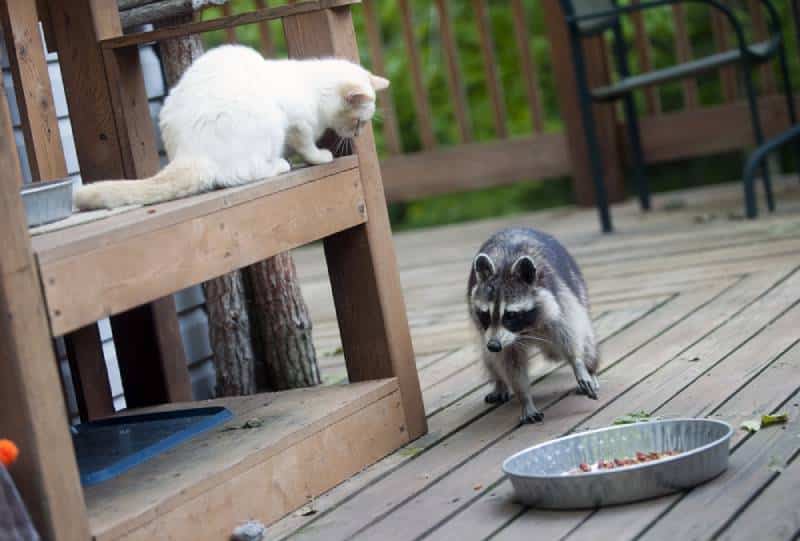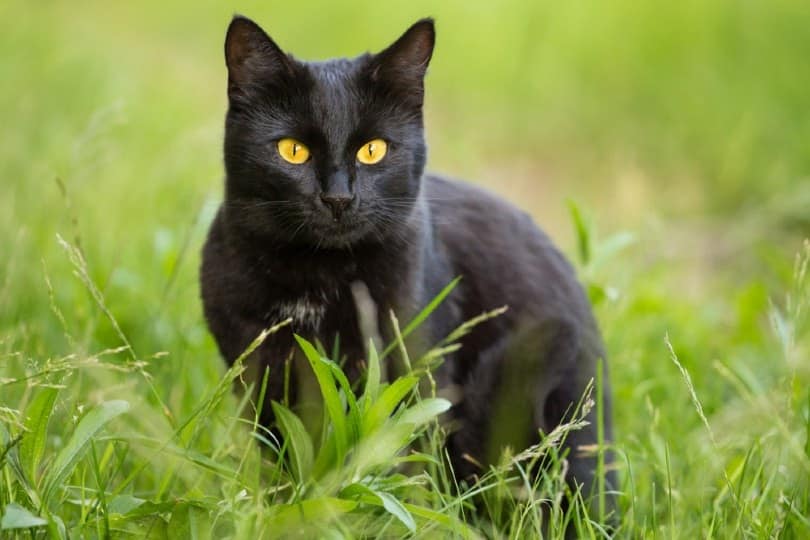
There’s an urban legend that says the majestic Maine Coon came from the cross of a Norwegian cat and a raccoon. This myth is likely due to the fact that the Maine Coon is a huge feline with distinctive markings that are somewhat reminiscent of a raccoon’s stripes. But while it’s true that cats and raccoons can sometimes cross paths, especially in urban and suburban areas, these encounters don’t end in tiny “cat-coon” or “rac-cat” babies. Cats and raccoons cannot mate and reproduce—no matter how adorable such offspring would be!
Let’s take a closer look at why some species can successfully interbreed and why this is not the case with cats and raccoons. There are also great tips on keeping your feline friend safe if they venture outside.
Can Two Different Species Mate?
It’s not that frequent in the wild, but two different but related species can indeed reproduce. This process is called hybridization, and it can happen in both animals and plants. When two different species mate successfully, their offspring is called a hybrid. Most of the time, hybrids are sterile, meaning they can’t have babies (though this isn’t always the case).
That said, scientists don’t all agree on how to define species. The “Biological Species Concept” is typically used to separate different animals and plants into various species. According to this principle, animals that cannot breed together or that can breed but produce sterile offspring are classified as different species.
Some scientists classify species based on notable physical and environmental differences—for example, differences in color, behavior, habitat, or geographic location. Other scientists use genetic differences, which are sections of DNA containing small differences called mutations. Typically, members of different species are unable to reproduce due to these genetic barriers. Indeed, this is the very definition of the term “species,” which comes back to the Biological Species Concept; two animals incapable of reproducing are classified as two different species.

Are All Hybrids Sterile?
While it’s true that most hybrids are unable to reproduce, there are instances where hybrids can have babies. This occurs when a hybrid mates with another hybrid or with a member of the same species as one of its parents. For example, when a male lion and a female tiger hybridize, they produce a liger. 90% of male ligers are sterile but most of the female ligers are fertile and can be successfully bred back to a tiger or a lion.
Interestingly, according to the authors of an article published in the journal Frontiers, the existence of fertile hybrids poses a certain scientific challenge, as it contradicts a fundamental principle of the Biological Species Concept, which suggests that two distinct species should not be capable of mating and producing fertile babies. However, this does not imply that the parents of hybrids are not distinct species; rather, it highlights that the concept of ‘biological species’ may not apply to all species.
So, Why Can’t Cats and Raccoons Mate?
You may have heard that cats and raccoons can sometimes mate, but these claims are not supported by any credible evidence. Scientifically, there are no documented cases of successful interspecies breeding between these two animals.
Cats and raccoons belong to distinct families within the order Carnivora. Indeed, cats are part of the Felidae family, while raccoons are classified in the Procyonidae family. If we look at the liger, which has a tiger mother and a lion father, we can see that even though they are different species, they belong to the same genus, Panthera, which explains their interbreeding success. This is not the case for raccoons and cats.

How to Keep Your Cat Safe Outdoors

Although cats and raccoons cannot mate, they do often cross paths in the wild, particularly in areas where human development encroaches upon natural habitats. These interactions can lead to a variety of outcomes, some of which can pose risks to your cat. Rabies, for example, is a significant concern, and raccoons are known carriers of this deadly virus. If your cat gets into a fight with a raccoon, there is a chance of disease transmission through bites or scratches.
Considering the potential risks posed by interactions with raccoons and other wildlife, it’s essential to take measures to ensure your cat’s safety when they venture outside.
Here are a few helpful tips:
- Monitor their time spent outdoors. If possible, try to supervise your cat’s comings and goings. To keep them truly safe, build a secure outdoor enclosure, commonly called a catio, to provide a safe outdoor space for your cat without exposing them to the dangers of wildlife.
- Keep your cat in your house at night. Since raccoons are primarily nocturnal creatures, it is best to keep your cat indoors in the evenings and at night.
- Make sure your cat’s vaccinations are up to date. This is especially important for diseases like rabies.
- Microchip your cat, and get them a collar with an identification tag. If they get lost or injured, this can increase the chances of their safe return.
- Spay or neuter your cat. Besides the various health benefits of these procedures, spaying or neutering your pet will greatly reduce their desire to roam and get into trouble. It will also reduce infections that are sexually transmitted such as Feline Immunodeficiency Virus (the cat version of HIV).
Bottom Line
Although interspecies breeding is technically possible and can even result in fertile hybrids like ligers, there is no scientific data proving that such a relationship can take place between a raccoon and a cat. That said, the risks linked to random encounters between these two species are very real, such as the transmission of contagious diseases or the risk of injury in the event of a fight.
Therefore, if you let your cat roam freely outside, make sure to monitor their comings and goings as much as possible, and above all, ensure that their vaccinations are up to date. Don’t try to attract raccoons to your home just because they seem adorable and harmless!
Featured Image Credit: Corina Muresan, Shutterstock
Credit : Source Post







